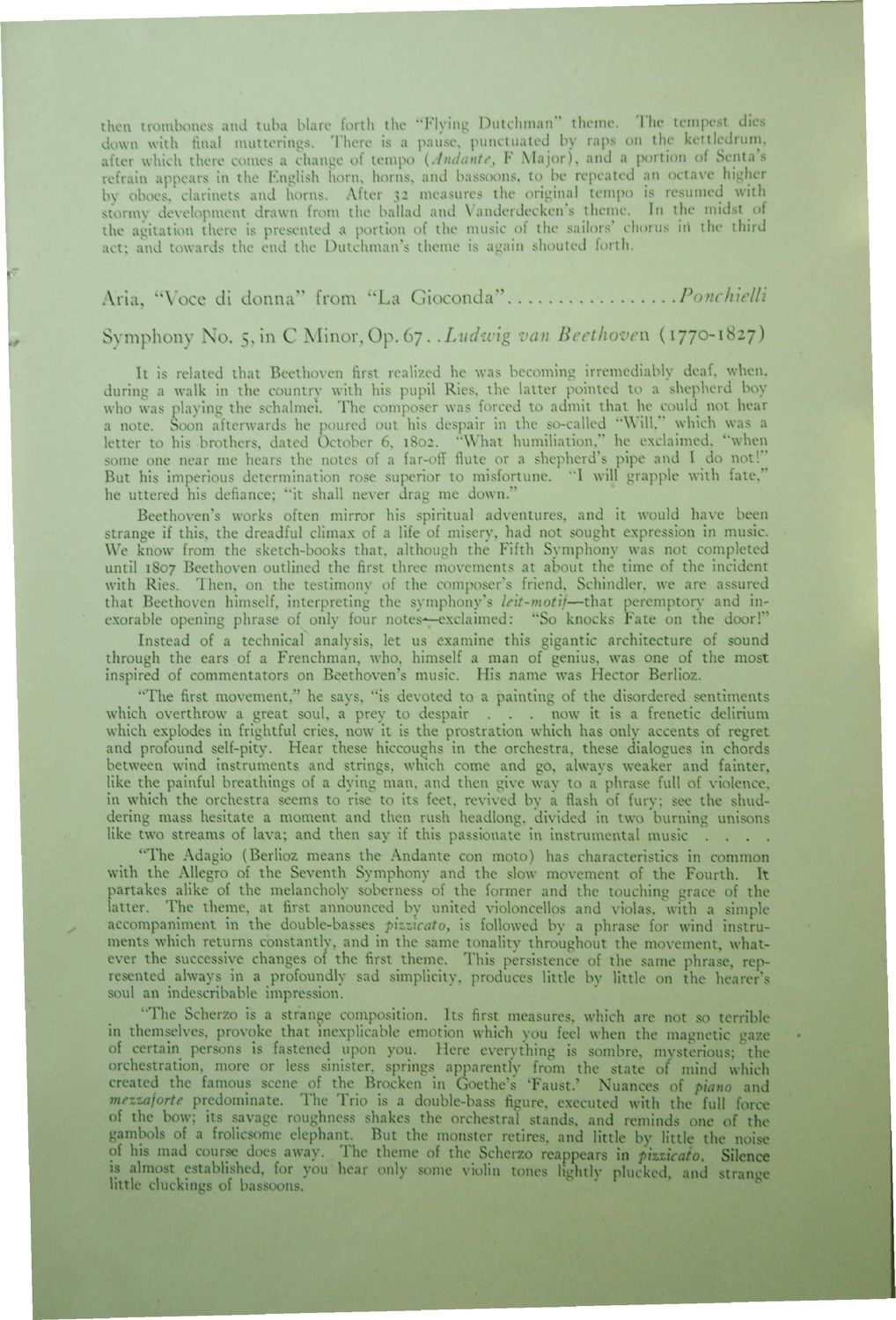| |
| |
Caption: Dedication - Smith Music Hall
This is a reduced-resolution page image for fast online browsing.

EXTRACTED TEXT FROM PAGE:
then trombones and tub* blare forth the "Flying Dutchman" theme. The tempest dies down with final muttcrings. There is a pause, punctuated by raps on the kettledrum, after which there comes a change of tempo (Andanttj F Major), and a portion of Senta's refrain appears in the English horn, horns, and bassoons, to be repeated an octave higher by oboes, clarinets and horns. After 32 measures the original tempo is resumed with stormy development drawn from the ballad and Vanderdecken's theme. In the midst of the agitation there is presented a portion of the music of the sailors' chorus in" the third act; and towards the end the Dutchman's theme is again shouted forth. Aria, "Voce di donna" from "La Gioconda" Ponchielli Symphony No. 5, in C Minor, Op. 67.. Lvdiuig van Beethoven (1770-1827) It is related that Beethoven first realized he was becoming irremediably deaf, when, during a walk in the country with his pupil Ries, the latter pointed to a shepherd boy who was playing the schalmei. The composer was forced to admit that he could not hear a note. Soon afterwards he poured out his despair in the so-called "Will," which was a letter to his brothers, dated October 6, 1802. "What humiliation," he exclaimed, "when some one near me hears the notes of a far-off flute or a shepherd's pipe and I do not!" But his imperious determination rose superior to misfortune. "I will grapple with fate/ he uttered his defiance; "it shall never drag me down." Beethoven's works often mirror his spiritual adventures, and it would have been strange if this, the dreadful climax of a life of misery, had not sought expression in music. We know from the sketch-books that, although the Fifth Symphony was not completed until 1807 Beethoven outlined the first three movements at about the time of the incident with Ries. Then, on the testimony of the composer's friend, Schindler, we are assured that Beethoven himself, interpreting the symphony's leit-motif—that peremptory and inexorable opening phrase of only four notes-^-exclaimed: "So knocks Fate on the door!" Instead of a technical analysis, let us examine this gigantic architecture of sound through the ears of a Frenchman, who, himself a man of genius, was one of the most inspired of commentators on Beethoven's music. His name was Hector Berlioz. "The first movement," he says, "is devoted to a painting of the disordered sentiments which overthrow a great soul, a prey to despair . . . now it is a frenetic delirium which explodes in frightful cries, now it is the prostration which has only accents of regret and profound self-pity. Hear these hiccoughs in the orchestra, these dialogues in chords between wind instruments and strings, which come and go, always weaker and fainter, like the painful breathings of a dying man, and then give way to a phrase full of violence, in which the orchestra seems to rise to its feet, revived by a flash of fury; see the shuddering mass hesitate a moment and then rush headlong, divided in two burning unisons like two streams of lava; and then say if this passionate in instrumental music . . . . "The Adagio (Berlioz means the Andante con moto) has characteristics in common with the Allegro of the Seventh Symphony and the slow movement of the Fourth. It partakes alike of the melancholy soberness of the former and the touching grace of the latter. The theme, at first announced by united violoncellos and violas, with a simple accompaniment in the double-basses pizzicato, is followed by a phrase for wind instruments which returns constantly, and in the same tonality throughout the movement, whatever the successive changes of the first theme. This persistence of the same phrase, represented always in a profoundly sad simplicity, produces little by little on the hearers soul an indescribable impression. "The Scherzo is a strange composition. Its first measures, which are not so terrible in themselves, provoke that inexplicable emotion which you feel when the magnetic gaze of certain persons is fastened upon you. Here everything is sombre, mysterious; the orchestration, more or less sinister, springs apparently from the state of mind which created the famous scene of the Brocken in Goethe's 'Faust.' Nuances of piano and mczzajorte predominate. The Trio is a double-bass figure, executed with the full force of the bow; its savage roughness shakes the orchestral stands, and reminds one of the gambols of a frolicsome elephant. But the monster retires, and little by little the noise of his mad course does away. The theme of the Scherzo reappears in pizzicato. Silence is almost established, for you hear only some violin tones hghtly plucked, and strange little duckings of bassoons.
| |